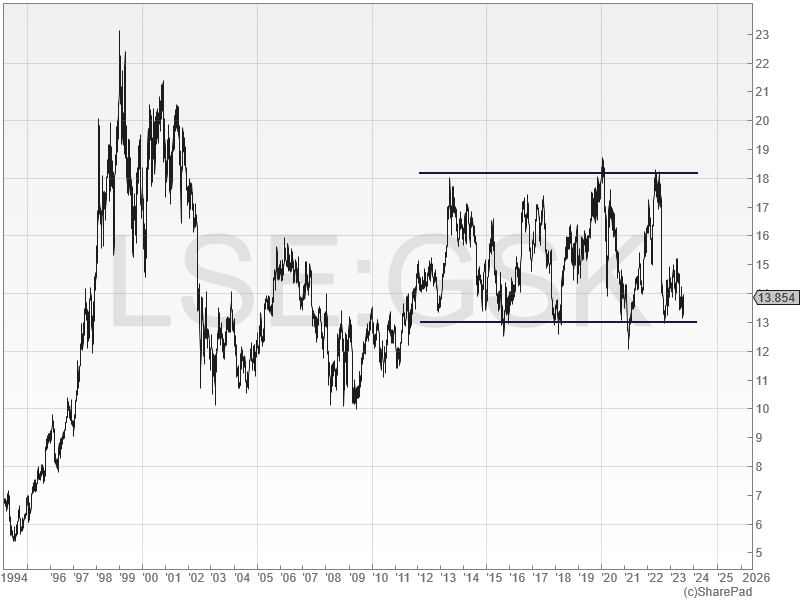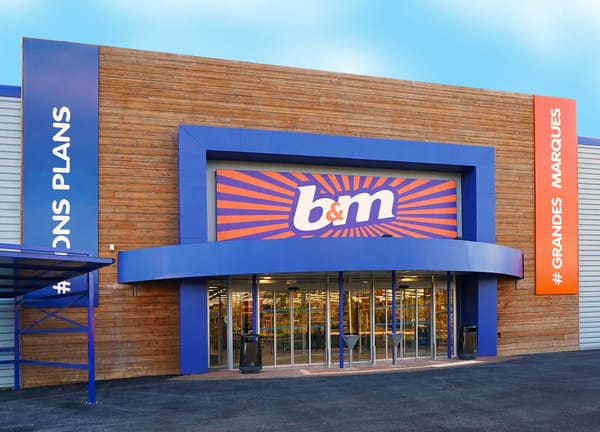Dividend notes: what happens next? LLOY, GSK, FDM (26/07/23)
I review half-year results from Lloyds and GSK and consider today's more downbeat commentary from IT group FDM.

Welcome back to my dividend notes. Today I've been looking at solid results from two FTSE 100 stalwarts – plus an IT services firm with an uncertain outlook.
Companies covered:
- Lloyds Banking Group (LON:LLOY) - half-year results show a fall in profits and an increase in bad debt provisions. But the overall picture still seems fairly benign. Lloyds' 6% dividend yield looks safe to me.
- GSK (LON:GSK) - half-year results show a healthy rise in profits and 30% operating margin. Cash generation was poor, but I expect this to improve. The shares look cheap to me, if GSK can return to growth.
- FDM Holdings (LON:FDM) - this IT services company saw demand slow during the second quarter. Full-year expectations are unchanged but are vulnerable to a downgrade, in my view.
These notes contain a review of my thoughts on recent results from UK dividend shares in my investable universe. In general, these are dividend shares that may appear in my screening results at some point.
As always, my comments represent my views and are provided solely for information and education purposes. They are not advice or recommendations.
Lloyds Banking Group (LLOY)
"Strong return on tangible equity of 16.6 per cent in the first half of 2023 and 13.6 per cent in the second quarter"
When I last wrote about this FTSE 100 bank in May, I commented that Lloyds management appeared to have left themselves some wiggle room for later in the year.
Despite the Q1 figures being better than expected, full-year guidance had been left unchanged.
Financial highlights: Today's half-year results show a mixed picture. Pre-tax profit for the second quarter fell by 29% to £1.6bn, compared to Q1. This reflected higher costs, a reduction in net interest income and an increase in provisions for bad debt.
The bank's net interest margin (NIM) during the second quarter fell to 3.14%, compared to 3.22% during the first quarter.
However, on a half-year view, both profits and NIM remain comfortably ahead of the same period last year thanks to the impact of higher interest rates.
Lloyds CEO Charlie Nunn now also expects to see a greater benefit from interest rates this year. The bank has updated its forecasts to suggest that rates will peak at 5.5% this year, compared to previous expectations of a 4% peak.
As a result, net interest margin for the full year is now expected to be at least 3.1%. This compares to February's guidance of 3.05% and a 2022 result of 2.94%.
Profitability & balance sheet: Bad debt provisions nearly doubled to £419m during Q2 (Q1 2023: £243m) but remain low in the context of the group's £451bn loan book.
The bank's CET1 ratio, a measure of surplus capital, was 14.2% at the end of the half year, compared to 14.7% one year ago.
Return on tangible equity improved to 16.6% during the six months to 30 June, compared to 11.8% for the same period last year.
Both balance sheet and profitability look strong to me.
Dividend: the interim dividend will rise by 15% to 0.92p per share, representing less than one quarter of half-year earnings of 3.9p.
This increase implies a full-year dividend of 2.8p, giving a prospective yield of 6%.
Outlook: the bank expects to generate a return on tangible equity greater than 14% this year. That's a solid figure which should provide decent support for continued dividend growth.
The group's asset quality ratio – a measure of bad debt – is expected to be c.0.3%, compared to 0.29% in H1. This seems to suggest the bank doesn't expect credit quality to worsen much more this year.
I don't think consensus forecasts will change all that much after today's results – current estimates put the stock on a P/E of 6 with a 6% dividend yield.
My view
Big banks are hard to analyse, but I don't think Lloyds' half-year results contained any serious surprises.
Lloyds' relatively affluent customer base does not yet seem to have been much affected by higher interest rates and a slowing economy. The main risk, in my view, is that this pain has been deferred, not avoided.
However, the bank's shares continue to trade in line with their tangible book value of c.46p per share and do not look expensive to me. I think Lloyds is probably decent value at current levels.
GSK (GSK)
"2023 guidance upgraded"
Like Lloyds, pharma giant GSK nudged up its full-year guidance after issuing its half-year results today. But as with Lloyds, the upgrade was marginal and the market reaction was minimal.
Financial highlights: revenue for the half year was stable at £14.1bn, but pre-tax profit rose by 30% to £3.9bn.
The group's operating margin for the half year was almost 30%, an impressive figure.
The increase in profits during H1 was due to lower cost of sales, which is said to be the result of a change in product mix to higher-margin items.
Sadly there was no progress on net debt, which rose by £1bn to £18.2bn. This was due to acquisition spending (£1.4bn) and rather poor cash flow.
GSK's operating cash flow fell to £1.9bn during H1, compared to £3.9bn in H1 2022. The company says this was due to the timing of a one-off settlement received last year, as well as working capital movements and pension contributions.
As a result, GSK reported an H1 free cash outflow of £341m (H1 2022: £1,741m inflow).
In fairness, six months is too short a period to draw many conclusions. Broker forecasts suggest full-year free cash flow of more than £5bn, so hopefully some of the outflows in H1 will unwind in H2.
Operating highlights: GSK reported sales growth across all three of its operating divisions, once Covid-19 related items were stripped out:
- Vaccines: H1 sales up 20% to £4,063m, led by shingles vaccine Shingrix (+20%)
- Specialty Medicines: H1 sales down 18% to £4,759m, due to the loss of Covid-19 sales. Excluding Covid sales, Specialty sales were up 16% to £4,728m
- General Medicines: sales rose by 8% to £5,307m, led by 12% growth in sales of respiratory medicines.
Outlook: GSK has increased its guidance (slightly) for the current year:
- Turnover is now expected to rise by 8%-10% (previously 6%-8%)
- Adjusted operating profit is expected to rise by 11%-13% (previously 10%-12%)
- Adjusted earnings per share are expected to rise by 14%-17% (previously 12%-15%)
- Full-year dividend guidance unchanged at 56.5p per share
Based on last year's adjusted earnings of 139.7p, my sums suggest earnings could hit 160p per share this year, before adjusting for currency effects.
Consensus forecasts prior to today were around 150p, so this isn't a massive upgrade.
My sums suggest GSK shares are now trading on about nine times forecast earnings, with a 4% yield.
My view
I covered GSK in an in-depth piece back in February. My view then was that the stock ought to be cheap, but the company still needs to prove it can convert its pipeline into successful commercial products.
These half-year results don't really change much for me.
I continue to think that the group's debt levels may still be slightly restrictive, in terms of supporting big acquisitions. I'd hope to see cash flow improve and borrowing come down during the second half of the year.
In the meantime, investors with more conviction or insight into GSK's pipeline might be able to snaffle a bargain. The shares offer an trailing 12-month EBIT/EV yield of 10%, according to my calculations.
The stock is also at the bottom of its 10-year trading range, which might suggest an opportunity to technically-minded investors:

I'm not going to change my view just yet. But my feeling is that GSK shares probably offer an opportunity at current levels.
FDM Holdings (FDM)
"After a good start to the year, market conditions weakened through the second quarter."
Shares in IT services provider FDM closed down by 9% after its half-year results were published, suggesting a weak outlook. This business trains IT consultants who are then deployed to customers – in effect, it's an outsourcer.
These half-year results weren't quite a profit warning, as expectations were unchanged. But note the use of "broadly" – in my experience, this is often translated as 'slightly below'...
"the Board anticipates that the Group's financial performance for the year as a whole will be broadly in line with its expectations"
Financial highlights: oddly enough, revenue and profits both rose during the first half of this year, despite emerging signs of weakness.
Revenue was up by 18% to £179.9m, while adjusted pre-tax profit was 4% higher, at £26.0m. Operating margin for the period was 16.3%, supporting an impressive trailing 12-month return on capital emoployed of 61%.
Turning to cash flow, this also improved. My sums suggest free cash flow for the half year of £14.3m, compared to just £5.7m in H1 2022.
However, this increased cash generation actually serves to highlight weaker trading. One of the main reasons why cash generation improved is that growth in receivables slowed. In other words, FDM did not take on as much new business as it did in H1 last year.
Trading commentary: FDM says that the year started well, but trading weakened during the second quarter.
The UK appears to have been the weakest region for the firm. The number of UK consultants assigned to clients fell by 15% to 1,743 and operating profit for the firm's home market fell by 21% to £12.2m.
Performance was more robust in the US and Asia.
Dividend: FDM's interim dividend was held unchanged at 17p per share. If the final dividend is also maintained at 19p, the resulting full-year payout of 36p would give a 6.4% yield.
Outlook: FDM is able to flex its headcount fairly quickly, but the company warns that "a backdrop of uncertain market conditions" are resulting in clients delaying budget decisions.
Management believe that "structural and systemic skills shortages" remain in all of its main markets and say client engagement remains encouraging.
However, the unchanged guidance for this year appears to rely on hopes that client confidence will improve in H2:
"We remain optimistic that there will be an improvement in client confidence as the second half progresses, and the Board anticipates that the Group's financial performance for the year as a whole will be broadly in line with its expectations."
Assuming broker forecasts remain unchanged, FDM now trades on about 14 times forecast earnings, with that 6.4% dividend yield I mentioned above.
My view
For such a profitable business, FDM's current valuation could be attractive, if performance stabilises. However, I'm not sure how likely this is.
I think there's a chance that weaker spending will persist for a while, as businesses adjust to higher interest rates and slowing economic growth.
FDM actually scores well in my screening, thanks to its strong profitability and (usually) good cash generation. I've owned the shares before, but sold them some time ago because I was no longer convinced by the group's business model.
The firm's consultant workforce mostly operates in entry-level roles, as far as I can tell, and I would guess that it's main attraction is its flexibility. FDM is essentially an IT temping agency, I think.
My feeling is the business could be vulnerable to cyclical swings. I think FDM could end up issuing a profit warning later this year.
I'm not inclined to back the stock at current levels, despite the potentially attractive yield.
Disclaimer: This is a personal blog/newsletter and I am not a financial adviser. All content is provided for information and educational purposes only. Nothing I say should be interpreted as investing advice or recommendations.
You should carry out your own research and make your own investing decisions. Investors who are not able to do this should seek qualified financial advice. Reasonable efforts are made to ensure that information provided is correct at the time of publication, but no guarantee is implied or provided. Information can change at any time and past articles are not updated.




